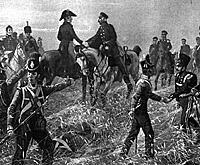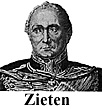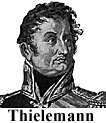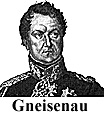
Editor Note: This material was adapted for EE&L by Matt DeLaMater from commentaries accompanying Ed Wimble's superbly researched La Bataille series of boardgames on the Waterloo campaign. As a wargame designer, Wimble's intention was not to break new ground with these commentaries. However, designing five separate simulations on the 1815 campaign gives him a unique perspective concerning events.
A wargame designer takes one step further the process of analysis available to the historian. Both can walk the contested ground, but the designer must also synthesize it to where "truths" stated in historical narratives become self-evident in the course of play. While we concur with Wimble's observations on the nature of wargame design, we must disagree with his assertion that he has not broken any new ground, as you will read.
One of the most celebrated aspects of the Waterloo Campaign is the apparent, remarkable recovery achieved by the Prussian Army after the battle of Ligny. Without taking anything for granted it seems we have to ask three questions.
Questions Three
- First, were the Prussians defeated to such an extent that their recovery from the effects of Ligny are worthy of being called remarkable or miraculous?
- The Prussians were in fact heavily defeated at Ligny, but, by and large, the formations which took the majority of losses there did not effectively perform in any further close combats;
- Therefore, the Prussian Army did not in fact truly "recover" after Ligny; and
- The so-called Prussian recovery was not an achievement of fact but of legend and historical misinterpretation. The Prussian's real achievement came from Blücher's stubborn loyalty, his daring, and the army's practical and timely use of available fresh forces.
Second, did the Prussian Army, in fact, recover from their defeat at Ligny in time to fight the battles of Waterloo and Wavre?
Third, how was this recovery achieved?
The answer to our first question is fairly self-evident. Losses suffered by the Prussian Army on the afternoon and night of the 16th were staggering by any standard. Scott Bowden, in Armies at Waterloo, gives a tally of 28,277 (including 10,000 deserters), or roughly one-third of Blücher's starting strength that day. But what is the key here is that nearly all the casualties suffered by the Prussians at this time were localized in their I and II Corps. The later battles of Waterloo and Wavre were fought by units of the III and IV Corps, units that either, or for the most part, observed the battle of Ligny or missed it altogether.
The only unit, for instance, that was in the thick of it at Ligny and then called up to fight again at Wavre, was the 19th Infantry Regiment from the I Corps. One must ask if its dismal display of martial spirit in defense of the Limal bridge can be attributed to: one, it was poorly led, in which case we must believe that Major Stengel had been given the impression by his superiors that his soldiers were to rest and recover in this out of the way corner (in the same manner that the shattered division of Girard currently guarded the Armee du Nord's communications with Charleroi), or; two, it had been so battered at Ligny it was incapable of putting up a decent defense in the face of Pajol's coup-de-main.
The truth of the matter lies somewhere between these two extreme interpretations; however, if we are going to talk the "remarkable Prussian recovery" an example thereof cannot be made of the 19th Infantry Regiment.
Casualties
If we use casualties as a means to establish the amount of combat a unit participated in, relative to other units that participated in the same battle, we can see which of the Prussian Corps did the bulk of the fighting at Waterloo. Relying on Bowden again, we see Prussian losses break down as follows:
-
I Corps: 317
II Corps: 326
IV Corps: 6,355
It should be apparent from these figures that the Prussian I Corps and II Corps had morale, rather than tactical effects on Napoleon's army. It should also be apparent that if these two corps had arrived at Waterloo earlier than they did they would have been called upon to bear more of the fighting, and would have suffered higher casualties as a result. Therefore, the order of march from Wavre on the 18th would determine the order in which the corps appeared at Waterloo as well as dictate which corps would the bulk of fighting.
If, as we have been led to believe, the Prussian Army had made a remarkable recovery from their defeat at Ligny then it should have made little difference to Blücher in what order his corps marched. This is even more significant when we remember that time was of the essence for Wellington. But the order in which the Prussian corps marched did make a difference to Blücher especially when we consider the eccentricities of the maneuver.
 Bülow's IV Corps was the furthest from Chapelle St. Lambert, the threshold of the Lasne defile upon which the French right flank at Waterloo rested unsupported. Zieten's I Corps was at least three hours closer in marching distance. Three hours can be critical, even decisive, yet Blücher and Gneisenau purposefully chose Bülow's formation to march before Zieten's.
Bülow's IV Corps was the furthest from Chapelle St. Lambert, the threshold of the Lasne defile upon which the French right flank at Waterloo rested unsupported. Zieten's I Corps was at least three hours closer in marching distance. Three hours can be critical, even decisive, yet Blücher and Gneisenau purposefully chose Bülow's formation to march before Zieten's.
This fact has trapped historians in an unfortunate conundrum which can be illustrated with the following syllogism: If the Prussian Army had recovered from their defeat at Ligny sufficient enough that they could provide the telling blow at Waterloo and continue the pursuit afterwards, and, if time was of the essence so that this blow must be struck before the Anglo-Allied Army were defeated, then, it must have been mistrust of the allies (Wellington in particular) that caused them to march to the aid of these same allies in as cautious a manner as was possible, as evidenced by the order of march.
The idea of a purposefully late time of arrival is brought even more to the fore if we analyze the positions of the various Prussian corps on the banks of the Dyle in the pre-dawn hours of 18 June The Prussian Army could not have moved any slower than it did! And, if one could somehow equate the distance to be marched, the order in which the corps were to march, with the degree of mistrust this exemplified in the march, then the Prussians must have trusted Wellington just a shade shy of not at all!
Why wasn't Thielemann's III Corps, which had already crossed to the west bank of the Dyle with all of its cavalry and three of its four infantry brigades, sent to lead the advance? It was ideally situated to march, if not on Chapelle St. Lambert, then upon Ohain. It could have marched upon that place by crossing the Lasne at Tombeck and reinforced any point of the Anglo-Allied line via La Hulpe. And, as we pointed out earlier, of all the corps at Ligny it was the least tested.
But this kind of question really only asks "what if Blücher had marched the III Corps ahead of the IV Corps?" What we must ask is why he chose to order his corps in the manner he did.
Order of March
 On the morning of the 18th, we see that Thielemann's III Corps had just arrived from its
position in the rearguard, which part of the corps, Borcke's 9th Brigade, still occupied. This Corps had just completed a march from Gembloux which it occupied until 2 p.m. the previous day.
On the morning of the 18th, we see that Thielemann's III Corps had just arrived from its
position in the rearguard, which part of the corps, Borcke's 9th Brigade, still occupied. This Corps had just completed a march from Gembloux which it occupied until 2 p.m. the previous day.
Another factor we should consider is that true darkness does not fall until around 10:30p.m. this time of year, while dawn is at roughly 3:30 a.m. Therefore, to say a unit arose at dawn is not to imply that it got a full night's sleep in the usual sense. Men that arrived in bivouac after dark could have at best snatched a few hours of rest, especially if they also had to boil their own soup. If Blücher had marched the III Corps ahead of the rest it would have done so in an exhausted state as well as leaving its strongest brigade behind.
But what of the I and II Corps? These units had arrived well ahead of the III Corps.
Of the four corps Blücher had at his disposal for the Waterloo campaign two were essentially considered corps of position. The two battle corps were the I and II Corps. Their brigades had their full compliment of regiments and support units (the sole exception being the 4th brigade of the I Corps which was missing the 13th Infantry Regiment which was still mobilizing at this time), and the ratio of old line regiments to Landwehr was two in three whereas in the other two corps the ratio of Landwehr to line regiments was just the opposite, or two-thirds militia to one-third regular line infantry. Only one of the III Corps' brigades met this standard, Borcke's 9th.
Battle vs. Position Corps
Ligny also provides an example of this distinction between the battle and position corps and their employment. The I Corps was the one that formed the actual line of battle along the length of Ligny creek, while the II Corps deployed behind it in support. The III Corps was on the left where it provided a final reserve and guarded the army's line of retreat to Liege, if that became necessary. Thus deployed, the I and II Corps did all the fighting at Ligny and suffered 95% of the Prussian casualties accordingly. Bowden gives the following numbers:
| Corps | Starting Strength | Casualties | Percent |
|---|---|---|---|
| I Corps | 33,965 | 8,588 | 25% |
| II Corps | 35,598 | 9,420 | 26% |
| III Corps | 27,749 | 764 | 3% |
| IV Corps | not present | ||
We can assume that the vast majority of the 10,000 deserters would also have come from the I and II Corps. If we apportion them at the same ratio as the casualties above, the numbers work out as follows:
| Corps | % of total casualties | estimate of deserters | new total | % of loss |
|---|---|---|---|---|
| I Corps | 45.7% | 4,570 | 13,158 | 38% |
| II Corps | 50.1% | 5,018 | 14,438 | 40% |
| III Corps | 4.0% | 400 | 1,164 | 4% |
There are probably a lot of people being counted twice in the totals above. Someone who fell out after being wounded, and then legged it for Liege had to be a fairly common phenomena that day. Also, we have no way of knowing how many of the lightly wounded dressed their own wounds and stayed in the ranks, or rejoined them on the retreat to Wavre. [Nor can we be certain that the Landwehr-heavy III Corps might not have had a significantly higher desertion rate than the battle corps, and thus both Bowden's figures on deserters and Mr. Wimbles' subsequent apportioning is only sophisticated estimation-Ed.]
Regardless of this, however, the two Prussian battle corps can be seen by these numbers to have been thoroughly thumped as a result of Ligny, and if the 19th Infantry Regiment is any example of what one could expect, as evidenced by its dismal performance at Limal, it would not be going too far to say that had Blücher led his march on Waterloo with either the I or II Corps, he would not be putting his best foot forward.
What would have happened if he had led with one of them or both, and as they debouched from the Lasne defile they had met with a strong French force of all arms? There can be little doubt that their progress would have been arrested at the head of their column, And what of their morale which at best could be now be described as brittle or shaken? There is no way one could expect the same sustained action as evidenced by the performance of the IV Corps in its repeated assaults on Plancenoit that day. Blücher knew that these corps would have only gotten in his way and sacrificed time for quality, much to Wellington's consternation.
Conclusion
 The statistical analysis of Blücher's casualties by Corps goes a long way toward showing that the Prussian "remarkable recovery" after Ligny is essentially a myth. What Blücher and Gneisenau really did was to economize their forces, such that they were able to fight three battles with three separate forces, each being relatively fresh for the engagement at hand. This operational economy matched Napoleon's, each respective Prussian brigade, with the exception of Borcke's 9th, saw hard employment at least once.
The statistical analysis of Blücher's casualties by Corps goes a long way toward showing that the Prussian "remarkable recovery" after Ligny is essentially a myth. What Blücher and Gneisenau really did was to economize their forces, such that they were able to fight three battles with three separate forces, each being relatively fresh for the engagement at hand. This operational economy matched Napoleon's, each respective Prussian brigade, with the exception of Borcke's 9th, saw hard employment at least once.
In returning to the three questions initially outlined, we have seen that:
The Army of the North: 16-18 June 1815 graphical representation: very slow, huge file: (397K)
Bibliography
Bowden, Scott, Armies at Waterloo, Empire Press, 1983. (Good analysis of the orders-of-battle.)
Chandler, David, Dictionary of the Napoleonic Wars, Macmillan, 1979.
Chandler, David, Waterloo, The Hundred Days, Macmillan, 1980.
Friederich, Rudolf v., Befreiungskriege 1813-1815, vol. IV, Mittler & Gohn, Berlin, 1910. (German text. The maps in this are excellent.)
Grossen Generalstafe Kriegs-geschichtliche Abteilung II, Das Preussische Heer in den Jahren 1814 und 1815, vol. 3, first published 1914, reprinted 1982 LTR Verlag. (Good order-of-battle information, you'd never have known there were so many men named Pirch in Blücher's army, listing every officer and decorations won!)
Henderson, E. F., Blucher 1806-1815, first published by G. P. Putnam's Sons, 1911. Reprinted 1994, R. J. Leach & Co., London.
Houssaye, Henry, 1815 Waterloo, originally published in 1900, reprinted 1991 by Worley Publications, Felling. (This book is a real treasure that has stood the test of time.)
[Editor's Note: This is only a partial bibliography of the sources Ed Wimble used for his works on the Waterloo campaign, but his notes on the books interested us so much we reproduced them.
Much of what we think we know about the Prussians in the 1815 campaign will be challenged by Peter Hofschröer's much awaited book, The Other Victory of Waterloo, to be published by Greenhill Press in 1996.]
Related:
Back to Empires, Eagles, & Lions Table of Contents #12
Back to Empires, Eagles, & Lions List of Issues
Back to MagWeb Master Magazine List
© Copyright 1995 by The Emperor's Press
[This article appears in MagWeb (Magazine Web) on the Internet World Wide Web.
Other military history articles and gaming articles are available at http://www.magweb.com]